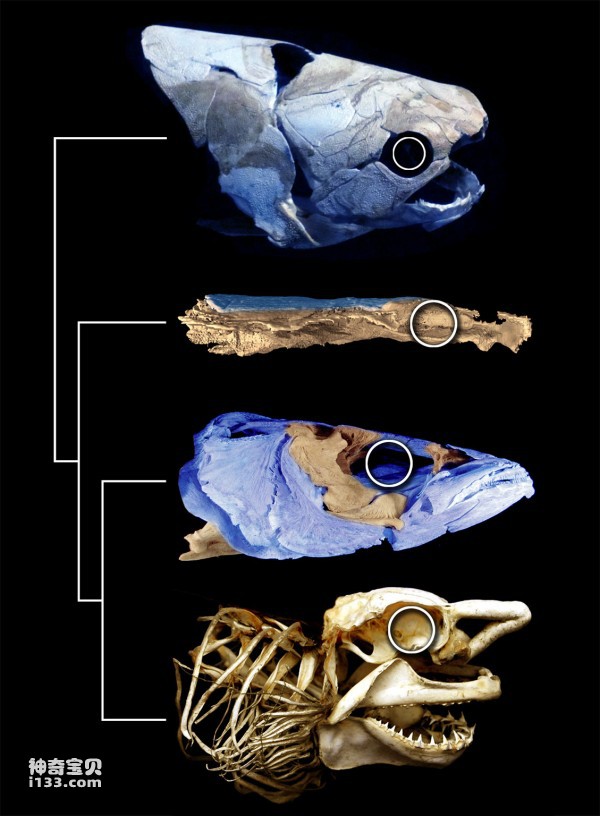When it comes to drawing the tree of life, the most important difference between humans and sharks is not limbs and fins, or even lungs and gills. All the differences can be boiled down to their bones. Shark bones are made of cartilage. They are called cartilaginous fish. However, like bony fish, humans and most other living vertebrates fall into another category—these are creatures whose bones are made of hard bone.

Devonian fish fossils from about 415 million years ago were discovered in Siberia.
Scientists already know that the two groups diverged about 420 million years ago, but who their last common ancestor was remains a mystery. Now, secrets discovered in the brain of a small fish fossil in Siberia, Russia, may provide some clues. The fossil material in question is a Devonian fish with a skull and scales found in Siberia about 415 million years ago.
As early as 1992, a brief scientific paper mentioned this fossil and classified it as a bony fish of the genus Dialipina based on the similarity of its scales and skull to the bony fish Dialipina from the New Siberian Islands. However, bony fish from the same period are very rare, so when paleontologist Martin Brazeau of Imperial College London, UK, found more detailed images of this Siberian fossil fish online, he and his colleague Sa Sam Giles and Matt Friedman of the University of Oxford believe it would be valuable to study the fish's origins in more detail.
To find out where this fish might have fit into the evolution of early jawed vertebrates, the researchers used a micro-CT scanning technique - similar to the regular CT imaging used by patients in hospitals to see inside their bodies. Observe the bone structure in their 1cm-long skulls without destroying the fossils.
The researchers found that although the fossil had previously been classified as a bony fish based on external morphology, such as the shape of its skull crest and the color of its scales, the CT scans revealed a surprising mosaic of characteristics of cartilaginous and bony fish.
For example, the fish's skull consisted of a large bony plate similar to that of today's bony fish, but the traces of blood vessels and nerves around its head were more similar to the shape of cartilaginous fish.
The researchers reported the discovery in the online edition of Nature on January 12. They named the fish janusiscus schultzei, after the ancient Roman god Janus.
The discovery suggests that the common ancestor of both branches of jawed vertebrates had features of bony fish that were later lost in the cartilaginous fish lineage, such as bony plates in the skull.
The finding supports a 2013 study that found several features thought to be unique to bony fishes, such as the presence of large plate-like bones, are actually present in shieldfish, an extinct jawed species. Fish, related to the ancestors of cartilaginous fish and bony fish.
The discovery also supports the findings of a 2014 study that showed a 325-million-year-old shark fossil had a surprising number of bony fish traits, meaning its ancestors also had those traits and that the sharks may have been older than previously thought. is more special.
Giles, the first author of the new study, points out that these findings as a whole can correct the misconception that cartilaginous fish are more primitive than bony fish.
Rather than one category being more ancient than the other, "the two groups of organisms have evolved different adaptations, and they have also retained primitive characteristics that are different from their ancestors." Giles explains, "Each organism found Different ways to solve the problems they encounter in the ocean they live in."
"Janusiscus is a fascinating discovery," said John Lang, a paleontologist at Flinders University in Adelaide, Australia. He emphasized that this is also an achievement that cannot be achieved without the use of sophisticated CT scanning technology. "The use of this modern technology is changing the way we conduct paleontological research by revealing new information in these critical transitional fossils," Long said.
Cartilaginous fishes include sharks, rays, rays, and silver sharks. Just before the Devonian shieldfish went extinct, bony and cartilaginous fish arose. Although cartilaginous fish have successfully combined into one group, the number of species (about 550 species) is still far less than that of modern bony fish (about 20,000 species). Cartilaginous fish and bony fish differ in many ways. The most obvious is that the skeleton of cartilaginous fish is composed of cartilage. Although the spine is partially ossified, actual bones are missing. Other features include 5 to 7 pairs of gill slits; the skin is covered with shield-like scales and has a tooth-like structure; and the mouth is lined with a large number of teeth. Most cartilaginous fish live in seawater, but there are also some freshwater sharks.
animal tags:
We created this article in conjunction with AI technology, then made sure it was fact-checked and edited by a Animals Top editor.